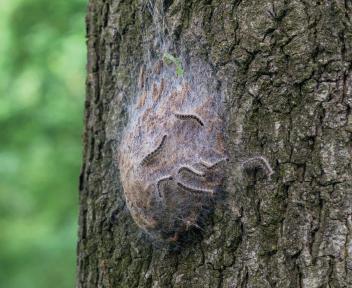
1 minute read
Tree health: oak processionary moth
The oak processionary moth not only strips oak trees of their leaves, leaving them vulnerable, but also poses a health risk to humans causing rashes and breathing difficulties.
What does oak processionary moth damage look like?
The oak processionary moth feeds and lives almost exclusively on oak trees. What does it do to the tree?
There is one generation of oak processionary moth per year. The caterpillars hatch in spring and go through several instars, eventually developing the irritating hairs. The caterpillars descend lower down the tree as they develop, stripping the tree of its leaves as they go, leaving it vulnerable and weakened.
In summer, they retreat into nests and pupate. The adult moths emerge in late summer, living for only four days in order to mate. The female lays her fertilised eggs high in the tree canopy and the cycle begins again. To find out more visit woodlandtrust.org.uk











